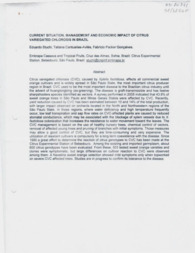Current situation, management and economic impact of citrus variegated chlorosis in Brazil.
Current situation, management and economic impact of citrus variegated chlorosis in Brazil.
Author(s): STUCHI, E.; CANTUARIAS-AVILÉS, T.; GONÇALVES, F. P.
Summary: Citrus variegated chlorosis (CVC), caused by Xylella fastidiosa, affects all commercial sweet orange cultivars and is widely spread in São Paulo State, the most important citrus producer region in Brazil. CVC used to be the most important disease to the Brazilian citrus industry until the advent of huanglongbing (ex-greening). The disease is graft-transmissible and has twelve sharpshooters species identified as vectors. A survey performed in 2005 indicated that 43.8% of sweet orange trees in São Paulo and Minas Gerais States were affected by CVC. Recently, yield reduction caused by CVC has been estimated between 10 and 14% of the total production, with larger impact observed on orchards located in the North and Northwestern regions of the São Paulo State. In those regions, where water deficiency and high temperature frequently occur, low leaf transpiration and sap flow rates on CVC-affected plants are caused by reduced stomatal conductance, which may be associated with the blockage of xylem vessels due to X. fastidiosa colonization that increases the resistance to water movement toward the leaves. The CVC management is based on the use of healthy nursery trees, chemical control of vectors, removal of affected young trees and pruning of branches with initial symptoms. Those measures may allow a good control of CVC, but they are time-consuming and very expensive. The utilization of resistant cultivars is compulsory for a long-term coexistence with the disease. Since 1990 a great effort to determine the reaction of citrus genotypes to CVC has been made at the Citrus Experimental Station of Bebedouro. Among the existing and imported germplasm, about 600 citrus genotypes have been evaluated. From these, 503 tested sweet orange varieties and clones were symptomatic, but large differences on cultivar reaction to CVC were observed among them. A Navelina sweet orange selection showed mild symptoms only when topworked on severe CVC affected trees. Studies are in progress to confirm its tolerance to the disease
Publication year: 2009
Types of publication: Abstract in annals or event proceedings
Unit: Embrapa Cassava & Fruits
Keywords: Citrus, Doença de Planta, Xylella Fastidiosa
Observation
Some of Embrapa's publications are published as ePub files. To read them, use or download one of the following free software options to your computer or mobile device. Android: Google Play Books; IOS: iBooks; Windows and Linux: Calibre.
Access other publications
Access the Agricultural Research Database (BDPA) to consult Embrapa's full library collection and records.
Visit Embrapa Bookstore to purchase books and other publications sold by Embrapa.

